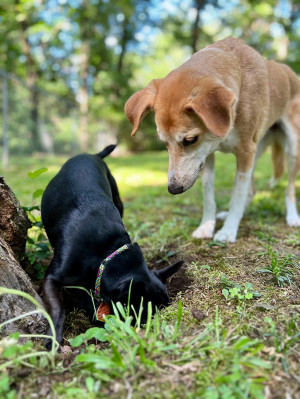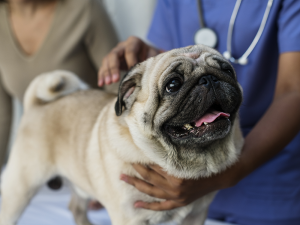Common Health Conditions in Shelter Dogs That Really Aren’t a Big Deal
Seriously, everything on this list is super treatable.

Share Article
Adopting from an independent rescue organization or an animal shelter is a great way to provide a loving home for a dog in need. Many of these dogs, however, have a patchy or even unknown history of veterinary care. This can put them at risk for some common issues, but luckily, they are all easily addressed.
Many independent organizations have the resources to treat these health problems before or after adoption. City or county shelters, on the other hand, may not be able to invest as much in each individual dog up for adoption because of the sheer number of animals they take care of. If you’re thinking about adopting a dog from a shelter (and you should), it’s a good idea to be aware of these common, and very treatable, health issues.
Fleas
Fleas are external parasites commonly found on stray dogs. They are easily diagnosed by thoroughly examining a dog’s coat and parting the fur to expose live fleas or flea droppings. Dogs with a severe flea infestation or flea allergy dermatitis will be super itchy and may develop skin irritation and patches of thin fur, especially on their backs, rumps, and thighs.
Treatment for fleas involves killing the live adult fleas with a soapy bath and possibly medication, as well as using a flea preventative. Getting rid of a flea infestation in a home or shelter is a complete pain in the butt, so catching and treating fleas as soon as possible is vital. Most shelters and rescue organizations will treat fleas and start dogs on flea preventatives before adoption, but it’s important to continue the treatment after your pet comes home as well.
How much do you spend on your pet per year?

Heartworm
Heartworms are internal parasites that are spread by mosquitoes and damage a dog’s heart, lungs, and blood vessels over time. Heartworm symptoms include coughing, exercise intolerance, and weight loss. Early on, dogs with heartworms may not display any symptoms, so many organizations make heartworm testing part of their health screening protocol prior to adoption.
Heartworm treatment is a lengthy process, often lasting several months. Treatment may involve a combination of antibiotics, steroids, Immiticide (an injectable medication that kills adult heartworms), and heartworm preventatives. During treatment, dogs must be monitored closely and generally should not take part in strenuous activities. Because full treatment takes a while, some dogs are adopted before it is complete. Dog parents who adopt a pup in the middle of treatment should communicate with the adoption organization and their veterinarian to make sure they are clear on the plan.
Anaplasmosis/Ehrlichia
Dogs who have spent extended time outdoors may be at risk for contracting a tick-borne disease like anaplasmosis or ehrlichiosis. As with heartworm, dogs who have these diseases can often be asymptomatic, so health screening blood work is a must. Dogs who are symptomatic can develop lethargy, inappetence, enlarged lymph nodes, joint pain, and fever. Dogs with severe cases can develop breathing difficulty, neurological changes, and abnormal bleeding.
Dogs that test positive during a health screening can clear an anaplasmosis or ehrlichiosis infection with antibiotics and supportive care. If the symptoms are mild, they can feel better within two days of starting treatment. After adoption, dogs should be kept on effective flea and tick preventatives to prevent future exposure.
Kennel Cough
Infectious tracheobronchitis, commonly called kennel cough, is an extremely contagious viral or bacterial respiratory infection. Dogs with kennel cough will develop a dry, persistent, hacking cough that can progress to a productive cough, nasal discharge, lethargy, and fever.
Because kennel cough is so contagious, dogs living in close quarters with other dogs — like in a shelter — are at high risk of contracting the virus. Dogs infected with kennel cough can sometimes spread the disease before they even start showing symptoms. If you have just adopted a dog, it’s best to keep your dog out of doggy daycare and dog parks for a couple of weeks just to be safe.
Because kennel cough is often a viral infection, treatment is usually symptomatic in nature. Many dogs do well with veterinary-prescribed cough suppressants, rest (away from other dogs, of course), and time. Dogs showing more severe signs like fever, lethargy, loss of appetite, or nasal discharge may require antibiotics due to concern about pneumonia or a secondary bacterial infection. Regardless of severity, dogs should be completely symptom-free before they socialize again.
Intestinal Parasites/Worms
Dogs can pick up intestinal parasites like hookworms, roundworms, whipworms, and tapeworms from their environment. Some worms are even passed from mom to pup, so shelter puppies with wormy poop are not at all uncommon. Symptoms of intestinal parasites include worms in the stool, bloody stool, diarrhea, weight loss, poor coat, and a pot-bellied appearance.
Intestinal parasites are easily treated with dewormers, though a fecal exam is needed to identify the types of worms present to ensure that the proper dewormer is prescribed. Routine fecal exams ensure there are no lingering intestinal parasites and monthly preventatives help keep dogs worm-free.
Demodex Mange
Demodectic mange is a skin infection caused by parasitic skin mites, primarily Demodex canis. In normal conditions, these mites will live in a dog’s hair follicles without causing any issues. But in dogs that are young or immunocompromised, the mites can overcome the body’s natural defenses, proliferate, and cause a skin infection.
Demodex usually occurs in dogs under one year of age. Symptoms include alopecia and crusty, red skin lesions that can be seen in one or two areas of the body (localized) or all over (generalized). This type of mange is not contagious and cannot be passed to other dogs or people. Demodectic mange should not be confused with sarcoptic mange, which is super contagious.
Demodex is diagnosed using skin scrapes, which is exactly what it sounds like: A vet will use a sterile blade to scrape the skin and look for mites under a microscope. Demodectic mange is typically treated with mite-killing medications. These can be oral or topical and are some of the same medications prescribed as monthly preventatives.
Your dog should continue medication until there are no mites found on at least two recheck skin scrapes, which is usually about two to three months. Treatment also involves addressing any secondary bacterial skin infections. In cases of mild, local disease, Demodex can spontaneously resolve within two months, but many vets recommend starting treatment rather than taking the “wait and see” approach.
Diarrhea
Diarrhea is likely when a pup finds a new home. A newly adopted dog may have juicy poops for relatively benign reasons, including stress and diet change. This is usually limited to just a few episodes, but can sometimes go on for several days.
Diarrhea that doesn’t quickly resolve on its own should be treated. This may involve changing to a bland diet, anti-diarrheal medication, and fluid therapy for dehydration. Dog parents can lower the risk of diarrhea from diet change by finding out what food their dog was fed prior to adoption and doing a slow transition over a week or two.
Malnourishment
Prolonged poor nutrition or lack of access to food can lead to malnourishment in dogs. This can then cause severe weight loss, dehydration, poor coat quality, lethargy, and weakness. Carefully restoring proper nutrition can get these dogs looking and feeling great, but you need to start slow.
Believe it or not, giving a starving dog lots of food can cause more harm than good. Truly emaciated dogs should be under veterinary care to ensure that nutrients are introduced properly to prevent refeeding syndromeopens in new tab — a condition where electrolyte imbalance can lead to muscle, nerve, and heart dysfunction. For skinny dogs with a history of malnourishment, vets may give specific feeding instructions regarding food type, amount, and feeding frequency. Dog parents should talk to the adoption organization and their vet to make a plan to get the pup to a healthy weight.
While adopting a dog from a shelter or rescue organization may sometimes come with challenges, remember that the rewards far outweigh them. New pup parents can overcome these bumps in the road by communicating with the shelter or organization, following veterinary advice, and having a little patience. It’s a small hurdle for the big reward of a long life with your new pup.
Resources:

Dr. Alycia Washington, DVM, MS
Alycia Washington is a small-animal emergency veterinarian with over 10 years of experience based in North Carolina. She works as a relief veterinarianopens in new tab and provides services to numerous emergency and specialty hospitals. She also works as a veterinary writer with a focus on educating pet parents.
Related articles
![A happy woman is lying on a bed, her dog smelling her face.]()
9 Diseases You Can (and Definitely Can’t) Catch From Your Dog
Here’s what you can scratch off your “Worry About This” list.
![Dog Drinking Water From A Pond In The Nature]()
Vets Issue A Warning After Two Dogs In Missouri Pass Away From Leptospirosis
The deadly disease is most common in autumn and late summer. Find out how to keep your pup safe.
![a pug is cradled by a person in scrubs with a stethoscope]()
Everything You Need to Know About Heartworm
Heartworm disease is as gnarly as it sounds. Here’s how to prevent a horror story from coming true for your pet.
![White and black spotted Great Dane with two different colored eyes looks into the camera]()
Here’s How You Can Prevent Dangerous Bloat in Your Dog
Bloat is one of the leading causes of death in deep-chested dogs. This elective surgery can lower the risk.








